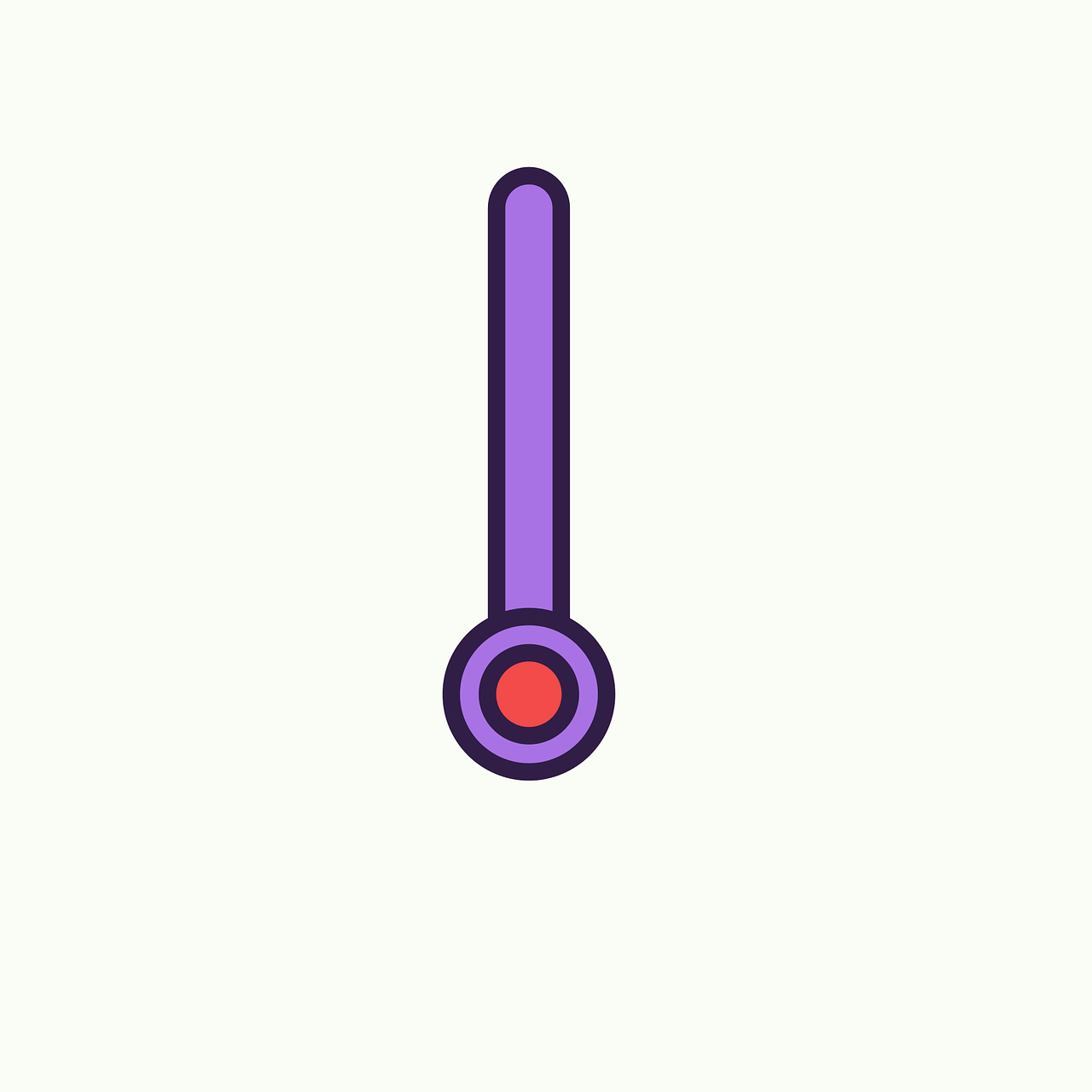If you are tired of constantly having to get up and adjust your thermostat every time you want to change the temperature, then you’ll be thrilled to know that there is a solution. With the rise of smart technology, controlling your thermostat has become easier than ever before. Gone are the days of fiddling with buttons and dials. Now, you can simply use a mobile app to control your smart thermostat from anywhere in the world. Whether you’re sitting on your couch or miles away on vacation, you have the power to control the temperature in your home with just a few taps on your phone. So, if you’ve been wondering if it’s possible to control your smart thermostat with a mobile app, the answer is a resounding yes!
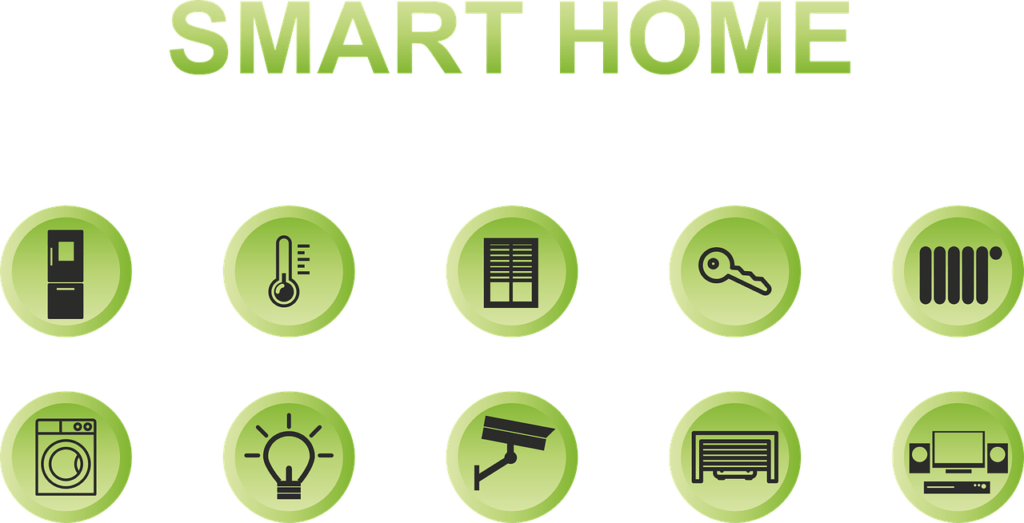
What is a smart thermostat?
A smart thermostat is a technologically advanced device that allows you to control and monitor the temperature settings of your home using a mobile app. It is a device that replaces traditional thermostats and offers a wide range of features and functionalities to make your life more convenient and comfortable. With a smart thermostat, you can easily adjust the temperature of your home remotely, create custom schedules, and even monitor your energy usage. It is a valuable addition to any modern home that seeks to maximize comfort and energy efficiency.
Definition of a smart thermostat
A smart thermostat is a device that connects to your home’s heating and cooling system and allows you to control and manage temperature settings through a mobile app. It utilizes advanced technology such as Wi-Fi connectivity, sensors, and automation to make your HVAC system more efficient and user-friendly. Unlike traditional thermostats that require manual adjustments, a smart thermostat can learn your preferences, adjust temperature settings automatically, and provide you with real-time data and insights. It is a convenient and innovative solution that puts you in complete control of your home’s climate.
Features of a smart thermostat
Smart thermostats are packed with a multitude of features that enhance their functionality and usability. Some key features of smart thermostats include:
Wi-Fi Connectivity: Smart thermostats have built-in Wi-Fi, allowing them to connect to your home network and enable remote control and monitoring through a mobile app. This feature ensures that you can control your thermostat from anywhere, anytime, as long as you have an internet connection.
Programmable Schedules: Smart thermostats allow you to create customized temperature schedules based on your routine and preferences. You can preset different temperature settings for specific times of the day or days of the week, ensuring optimal comfort and energy savings.
Energy Saving Insights: Smart thermostats provide you with real-time data and insights about your energy usage, allowing you to make informed decisions to reduce consumption and save money on your utility bills. They often come with energy usage reports and recommendations that help you identify wasteful practices and optimize your HVAC system’s efficiency.
Geofencing: Geofencing is a feature that uses your smartphone’s GPS to detect when you’re away from home and automatically adjust the temperature settings accordingly. This ensures that you’re not wasting energy heating or cooling an empty house and enables significant energy savings.
Integration with Smart Devices: Smart thermostats can integrate with other smart home devices, such as voice assistants, smart lighting systems, and security systems. This allows for seamless automation and control of various aspects of your home, providing a more cohesive and convenient smart home experience.
Weather Integration: Some smart thermostats offer integration with weather forecasting services, allowing them to adjust temperature settings based on local weather conditions. This feature ensures that your home stays comfortable while optimizing energy usage based on external factors.
Smart Assistant Voice Control: Many smart thermostats support voice control through popular smart assistants like Amazon Alexa or Google Assistant. This means you can simply use voice commands to adjust the temperature or ask for information about your HVAC system, adding an extra layer of convenience to your smart home ecosystem.
Energy Optimization Algorithms: Smart thermostats often come equipped with advanced energy optimization algorithms that help you achieve the optimal balance between comfort and energy savings. These algorithms continuously analyze your energy consumption patterns and adjust temperature settings accordingly, maximizing efficiency and reducing waste.
Mobile App Control: The key feature of a smart thermostat is its compatibility with a mobile app. This allows you to control and monitor your thermostat remotely, making adjustments and accessing features from the convenience of your smartphone, tablet, or computer.
Benefits of using a mobile app for smart thermostat control
Convenience and accessibility
One of the primary benefits of using a mobile app for smart thermostat control is the unparalleled convenience it provides. With a mobile app, you can control and monitor your thermostat from anywhere, as long as you have an internet connection. Whether you’re at work, on vacation, or simply relaxing on your couch, you can easily adjust the temperature settings to ensure your home is comfortable when you arrive.
Moreover, a mobile app eliminates the need for physical interaction with the thermostat itself. Instead of getting up and walking over to the thermostat to make adjustments, you can simply reach for your smartphone and make the changes with a few taps. This level of convenience saves you time and effort, making it easier than ever to maintain the perfect temperature in your home.
Remote control and monitoring
Gone are the days of having to manually adjust your thermostat every time you want to change the temperature. With a mobile app, you can remotely control your smart thermostat with ease. Whether you want to turn up the heat on a chilly winter day or cool down your home during a hot summer, you can do it all from the palm of your hand.
The ability to remotely monitor your smart thermostat also provides peace of mind and control. If you’re away from home and want to check the current temperature or verify that your HVAC system is functioning properly, you can simply open the mobile app and access real-time data and insights. This level of control allows you to proactively address any potential issues and ensures that your home’s climate is always in your hands.
Energy saving features
Smart thermostats are designed with energy efficiency in mind, and mobile apps play a crucial role in unlocking their full potential. With a mobile app, you can easily access and utilize energy-saving features that help reduce your carbon footprint and lower your utility bills.
One of the key energy-saving features offered by smart thermostats is programmable schedules. With a mobile app, you can create custom schedules based on your daily routine, ensuring that your HVAC system operates efficiently when you need it and reduces energy consumption when you don’t. This feature allows you to maximize comfort while minimizing waste, resulting in significant energy savings over time.
Geofencing is another energy-saving feature that can be controlled through a mobile app. By leveraging your smartphone’s GPS, the smart thermostat can detect when you’re away from home and automatically adjust the temperature settings to an energy-saving mode. This ensures that you’re not unnecessarily heating or cooling an empty house, saving energy and money in the process.
Integration with other smart devices
In today’s connected world, having a smart home that seamlessly integrates various devices is becoming increasingly popular. Smart thermostats, with their mobile app control, offer seamless integration with other smart devices, further enhancing the convenience and functionality of your home automation system.
By integrating your smart thermostat with other smart devices, such as voice assistants, smart lighting systems, or security systems, you can create a cohesive ecosystem that responds to your needs. For example, you can set up routines or scenes that automatically adjust the temperature, lighting, and security settings when you come home or go to bed. This level of automation not only makes your life more convenient but also contributes to energy savings by ensuring that your home operates efficiently based on your specific preferences.

Compatibility of smart thermostats with mobile apps
Major smart thermostat brands offering mobile app control
When it comes to smart thermostats, there are several major brands that offer mobile app control as a standard feature. These brands have established themselves as leaders in the industry and provide reliable and user-friendly mobile apps for controlling their smart thermostats. Some of the leading smart thermostat brands include:
Nest: Nest, a subsidiary of Google, is one of the most recognized and widely used brands in the smart thermostat market. Their mobile app, Nest app, offers a seamless and intuitive interface that allows you to control and monitor your Nest thermostat effortlessly. It provides detailed energy usage reports, personalized recommendations, and integration with other Nest smart home devices.
Ecobee: Ecobee is another popular smart thermostat brand known for its advanced features and energy-saving capabilities. The Ecobee mobile app offers a user-friendly interface that allows you to control and monitor your Ecobee thermostat from anywhere. It provides access to energy reports, scheduling options, and smart alerts to keep you informed about your HVAC system’s performance.
Honeywell: Honeywell is a trusted name in the HVAC industry, and its smart thermostats offer reliable performance and a range of features. The Honeywell Home mobile app allows you to control and monitor your Honeywell thermostat remotely, create custom schedules, and receive energy-saving tips. It also integrates with other Honeywell smart home devices for seamless automation.
Emerson Sensi: Emerson Sensi is known for its user-friendly smart thermostats that offer a balance of affordability and functionality. The Sensi mobile app provides easy-to-use controls and allows you to adjust temperature settings, create schedules, and monitor energy usage. It also offers smart alerts and allows integration with popular smart assistants like Amazon Alexa and Google Assistant.
Types of mobile devices supported
Smart thermostat mobile apps are designed to be compatible and accessible across a wide range of mobile devices. Whether you own an iOS or Android device, you can typically find a mobile app that supports your preferred platform.
Most smart thermostat mobile apps are available for download through the Apple App Store for iOS devices such as iPhones and iPads. They are also available through the Google Play Store for Android devices, including smartphones and tablets. These apps are designed to provide a consistent and user-friendly experience across different devices, ensuring that you can easily control and monitor your smart thermostat regardless of the device you use.
Operating system requirements
To ensure smooth and optimal performance, smart thermostat mobile apps often have specific operating system requirements. These requirements typically vary depending on the brand and version of the mobile app. It’s important to check the app’s compatibility with your device’s operating system before downloading and installing it.
For iOS devices, smart thermostat mobile apps often require a minimum operating system version, such as iOS 11 or later. This ensures that the app can take advantage of the latest features and functions seamlessly on Apple devices. Similarly, for Android devices, the mobile apps may require a specific minimum version of the Android operating system, such as Android 6.0 or higher, to ensure compatibility and performance.
Setting up your smart thermostat with a mobile app
Connecting your smart thermostat to a mobile app
Setting up your smart thermostat with a mobile app usually involves a few simple steps. While the exact process may vary depending on the brand and model of your smart thermostat, the following are general steps to connect your smart thermostat to a mobile app:
Download and install the mobile app: Begin by downloading and installing the mobile app for your specific smart thermostat brand. You can typically find the app in the Apple App Store or Google Play Store.
Create an account: Launch the app and follow the prompts to create a new account. This may involve providing your email address, creating a password, and agreeing to the terms and conditions.
Power up your smart thermostat: Install your smart thermostat according to the manufacturer’s instructions and power it up. This may involve connecting it to your home’s HVAC system and supplying the necessary power source.
Connect the thermostat to your home network: Use the mobile app to connect your smart thermostat to your home’s Wi-Fi network. This usually involves entering your network name (SSID) and password.
Complete the registration process: Once connected, follow the app’s instructions to complete the registration process. This may involve scanning a QR code on the thermostat or entering a unique identifier to link it to your account.
Test the connection: After completing the registration process, the app will attempt to connect to your smart thermostat. This may involve a brief waiting period while the app establishes communication with the device.
Set up initial settings: Once connected, you can customize the initial settings of your smart thermostat through the mobile app. This may include setting the date and time, configuring preferred temperature units (Fahrenheit or Celsius), and personalizing other settings.
After completing these steps, your smart thermostat should be successfully connected to the mobile app, and you can begin controlling and monitoring it remotely.
Account creation and login
Creating an account is a crucial step in setting up a smart thermostat with a mobile app. The account allows you to securely access and manage your smart thermostat from multiple devices, ensuring a seamless and consistent experience.
During the account creation process, you will typically be asked to provide your email address, create a password, and agree to the terms and conditions. It is important to choose a strong and unique password to protect your account from unauthorized access. Additionally, be sure to provide a valid email address as it may be used for important notifications and account-related communications.
Once you have created your account, you can log in to the mobile app using your credentials. The login process usually involves entering your email address and password. Some smart thermostat mobile apps also offer biometric authentication options, such as fingerprint or facial recognition, for added security and convenience.
Syncing multiple devices
Smart thermostat mobile apps typically allow you to sync your account across multiple devices. This means that you can control and monitor your smart thermostat from different smartphones, tablets, or computers, as long as they are logged in with the same account credentials.
To sync multiple devices, simply download the smart thermostat mobile app on the desired device and log in using your account credentials. Once logged in, the app will automatically synchronize the settings and preferences associated with your account, ensuring a consistent experience across all devices.
Syncing multiple devices is particularly useful for households with multiple residents, as everyone can have access to the smart thermostat controls and monitor the temperature settings from their respective devices. It also comes in handy if you want to control the thermostat while away from home using a different device from the one you initially set up.
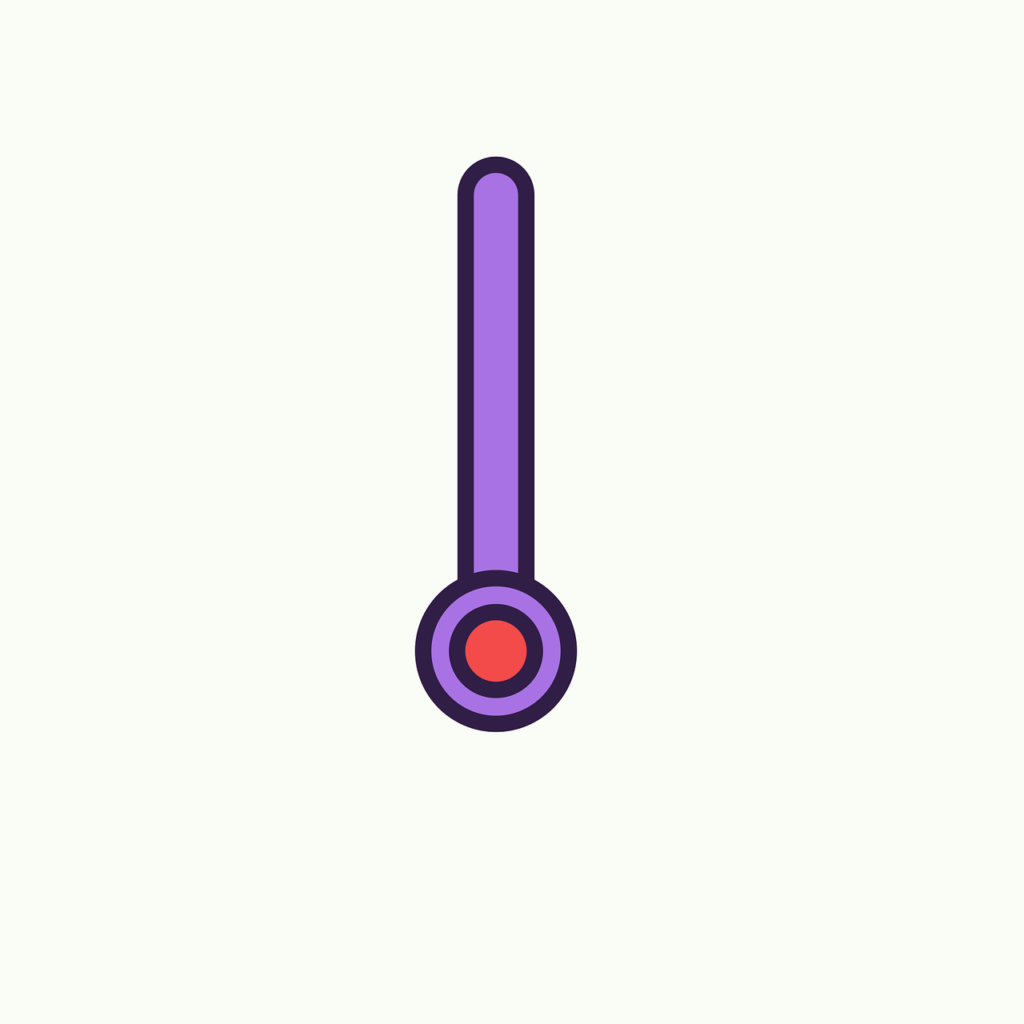
Controlling your smart thermostat with the mobile app
Adjusting temperature settings remotely
One of the primary benefits of using a mobile app for smart thermostat control is the ability to adjust the temperature settings remotely. Whether you’re on the couch, at work, or on vacation, you can easily control the temperature of your home with just a few taps on your smartphone.
Using the mobile app, you can increase or decrease the temperature of your smart thermostat to suit your comfort preferences. For example, if you’re on your way home and want to arrive to a warm and cozy house, you can use the app to adjust the thermostat accordingly. Similarly, if you forget to adjust the temperature before leaving home, you can do it remotely and avoid wasting energy on an empty house.
The mobile app usually provides an intuitive interface that allows you to easily set the desired temperature. It may offer sliders or numeric input options to adjust the temperature to the exact degree you prefer. Once you make the changes in the app, the smart thermostat will promptly respond and adjust the temperature accordingly.
Creating custom schedules
Smart thermostats offer the flexibility to create custom temperature schedules based on your daily routine and preferences. Through the mobile app, you can easily create and manage these schedules, ensuring that your home maintains the perfect temperature at different times of the day or week.
To create a custom schedule, simply open the mobile app and access the scheduling settings. Most apps provide a visual interface that allows you to easily define different temperature settings for specific time slots. For example, you can set a higher temperature in the morning when you wake up, lower it during the day when you’re at work, and increase it again in the evening when you return home.
The scheduling feature allows you to fine-tune the temperature settings of your home without having to manually adjust the thermostat throughout the day. This not only saves you time and effort but also helps maximize energy savings by only heating or cooling your home when needed.
Monitoring energy usage
Smart thermostats are designed to help you monitor and manage your energy usage more effectively. Through the mobile app, you can access real-time data and insights about your HVAC system’s performance and energy consumption.
The energy usage monitoring feature typically provides detailed reports and statistics that show your daily, weekly, or monthly energy usage. This allows you to identify patterns and trends, helping you understand which activities or settings contribute to higher energy consumption.
By monitoring your energy usage, you can make informed decisions about adjusting your temperature settings or adopting energy-saving practices. For example, if you notice that your energy usage spikes during certain hours, you can analyze the data and determine the cause. It could be due to excessive use of heating or cooling during peak demand hours, prompting you to optimize your schedules or enable energy-saving features like geofencing.
Some mobile apps also offer personalized recommendations and tips based on your energy usage data. These recommendations help you identify areas for improvement and suggest energy-saving practices that can further reduce your environmental impact and utility bills.
Setting up geofencing
Geofencing is a powerful feature of smart thermostats that can be configured through the mobile app. Geofencing leverages your smartphone’s GPS capabilities to detect when you’re away from home and automatically adjust the temperature settings accordingly.
To set up geofencing, the mobile app typically prompts you to define a boundary or area around your home. This boundary represents the geofence, and when your smartphone enters or exits this boundary, the smart thermostat will respond accordingly.
For example, if the mobile app detects that you have left the geofence, it can automatically set the temperature to an energy-saving mode, keeping your home comfortable while minimizing energy consumption. Conversely, when you approach your home and enter the geofence, the thermostat can adjust the temperature back to your preferred comfort settings.
Geofencing provides significant energy savings by preventing unnecessary heating or cooling of an empty house. It ensures that your home is at the desired temperature when you arrive and that you’re not wasting energy on climate control when nobody is home.
Configuring smart home automation
Smart thermostats, when integrated with other smart home devices, can enable sophisticated automation scenarios that enhance the overall convenience and functionality of your home. Through the mobile app, you can configure various smart home automation routines and rules that are triggered based on specific events or conditions.
For example, you can set up a routine that automatically adjusts the temperature settings when a specific smart sensor detects motion or a door is opened. This allows your thermostat to respond to events in real-time, ensuring optimal comfort and energy efficiency.
Another example is integrating your smart thermostat with your wake-up routine. Through the mobile app, you can configure the thermostat to gradually increase the temperature before your alarm goes off, ensuring that you wake up to a comfortable environment.
The mobile app typically provides an interface where you can define the automation rules and specify the conditions, triggers, and actions. This allows for highly personalized and tailored automation that aligns with your lifestyle and preferences.
Additional features and functionalities of smart thermostat mobile apps
Energy usage reports and insights
In addition to monitoring your energy usage, smart thermostat mobile apps often provide detailed reports and insights that help you understand and control your energy consumption. These reports can give you a breakdown of your energy usage by day, week, or month and provide clear visualizations of the data.
Energy usage reports allow you to identify trends and anomalies in your energy consumption, helping you make informed decisions to optimize efficiency and reduce waste. The reports may provide information about specific HVAC system components, such as heating or cooling, and show how they contribute to your overall energy usage.
Insights provided by the mobile app can include personalized recommendations for energy savings, highlighting areas where you can make adjustments to reduce your environmental impact and save money on your utility bills. For example, the app may suggest adjusting temperature schedules, enabling energy-saving features like geofencing, or utilizing specific modes or settings to promote energy efficiency.
Overall, energy usage reports and insights empower you to take control of your energy consumption and make conscious choices to minimize waste and maximize savings.
Weather integration
Weather integration is a valuable feature that some smart thermostat mobile apps offer. With this feature, your smart thermostat can take into account current and forecasted weather conditions when adjusting temperature settings.
By leveraging weather information, the mobile app can ensure that your home stays comfortable while optimizing energy usage. For example, if the app detects that an unusually warm day is ahead, it can proactively adjust your temperature settings to prevent excessive cooling and potential energy waste.
Weather integration can also provide alerts or notifications about severe weather conditions, allowing you to take appropriate actions to enhance your comfort and safety. For instance, if the app detects an abnormally cold day, it can notify you to increase the temperature settings or even suggest precautions like protecting exposed pipes to prevent freezing.
Integrating weather data into your smart thermostat control gives you a holistic understanding of the factors influencing your home’s climate. It allows for more accurate temperature adjustments that align with current weather conditions, improving overall comfort and energy efficiency.
Smart assistant voice control
Smart thermostats, when paired with popular smart assistants like Amazon Alexa or Google Assistant, offer the convenience of voice control through the mobile app. This feature allows you to adjust temperature settings, change modes, or access other thermostat functions using simple voice commands.
To enable voice control, you typically need to link your smart thermostat mobile app with your preferred smart assistant. Once linked, you can use voice commands to control your thermostat without having to open the app or physically interact with the thermostat.
For example, you can say “Hey Google, set the thermostat to 68 degrees” or “Alexa, increase the temperature by 2 degrees” to adjust the climate of your home. Voice control through the mobile app offers a hands-free and intuitive experience, making it easy to control your thermostat while you’re busy with other tasks or simply prefer the convenience of voice commands.
Integration with utility programs
Smart thermostat mobile apps often integrate with utility programs or initiatives that promote energy efficiency and conservation. These programs are designed to incentivize users to adopt energy-saving practices by offering rewards, rebates, or other incentives.
The mobile app may provide information about available utility programs in your area, allowing you to participate and take advantage of potential benefits. For example, some utilities offer time-of-use pricing, where electricity rates vary based on the time of day. The smart thermostat can help you optimize your energy usage by automatically adjusting temperature settings during periods with lower electricity rates.
Other utility programs may involve demand response initiatives, where homeowners voluntarily reduce their energy consumption during peak demand periods. With the help of the smart thermostat mobile app, you can easily participate in such programs and contribute to grid stability and energy conservation efforts.
By integrating with utility programs, smart thermostat mobile apps help you make choices that align with broader energy-saving initiatives. They provide information and tools that empower you to actively participate in reducing your environmental impact and potentially benefit from cost savings.
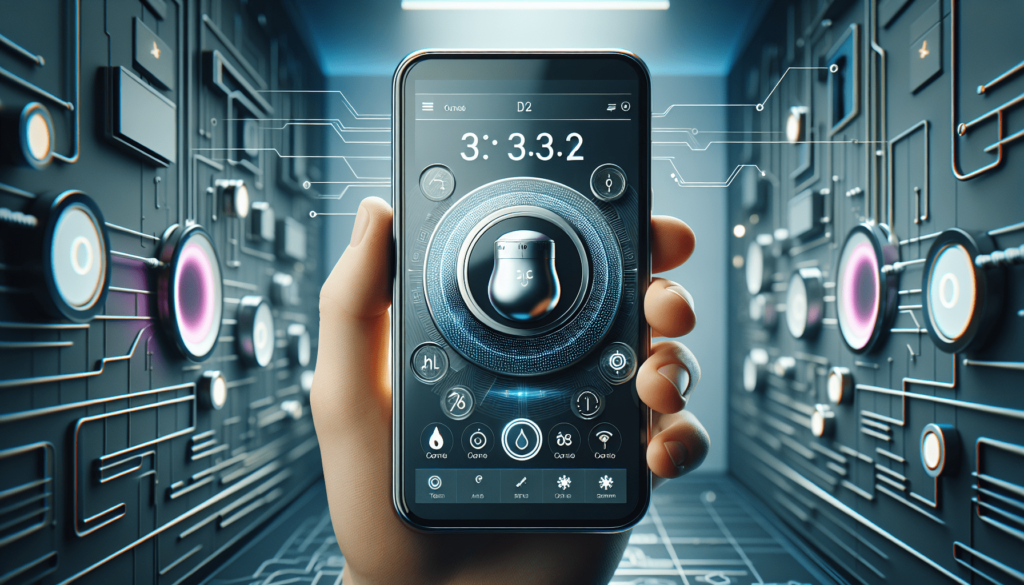
Security considerations for smart thermostat mobile apps
Protecting personal data
When using a mobile app to control your smart thermostat, it is essential to consider the security of your personal data. Smart thermostat mobile apps may collect and store sensitive information, such as your email address, home address, and temperature preferences.
To protect your personal data, it is important to choose a reputable smart thermostat brand and ensure that the mobile app follows industry best practices for data security. The app should have robust security measures in place to safeguard your personal information from unauthorized access or misuse.
When downloading and installing the mobile app, pay attention to the permissions it requests. Only grant the necessary permissions required for the app to function properly. For example, if the app requests access to your location, ensure that it is for geofencing purposes and does not involve unnecessary data collection or tracking.
It is also advisable to review the privacy policy of the mobile app and the smart thermostat brand. The privacy policy should outline how your personal data is collected, stored, and used. Look for assurances of data encryption, anonymization, and adherence to relevant privacy regulations to ensure that your information is handled responsibly.
Implementing strong passwords
To further enhance the security of your smart thermostat mobile app, it is crucial to implement strong and unique passwords. A strong password consists of a combination of letters, numbers, and special characters that are not easily guessable. Avoid using common passwords or personal information that can be easily associated with you.
Creating unique passwords for each online account, including the mobile app, is also important. In the event that one account is compromised, having a unique password ensures that other accounts remain secure.
Additionally, consider using a password manager to generate and securely store your passwords. Password managers provide a convenient way to create and manage complex, unique passwords without the need to remember them.
Enabling two-factor authentication
Two-factor authentication (2FA) adds an extra layer of security to your smart thermostat mobile app by requiring a second form of verification to access your account. It typically involves a combination of something you know (such as a password) and something you possess (such as a code sent to your phone).
Enabling 2FA for the mobile app ensures that even if someone gains access to your password, they won’t be able to log in to your account without the additional verification step. This significantly reduces the risk of unauthorized access and protects your sensitive information.
The mobile app should provide an option to enable 2FA through settings or account preferences. Follow the app’s instructions to set up 2FA and choose a secure method, such as SMS-based codes or authenticator apps, for receiving the second factor of verification.
Updating firmware and app regularly
To maintain optimal security, it is important to keep both your smart thermostat’s firmware and the mobile app up to date. Smart thermostat manufacturers often release firmware updates that include security patches and bug fixes to address vulnerabilities.
The mobile app should provide notifications or alerts when a new firmware update is available for your smart thermostat. Follow the manufacturer’s instructions to install the update, ensuring that your device is protected against any known security risks.
Similarly, regularly updating the mobile app itself is crucial. App updates often include security improvements, performance enhancements, and new features. Set your mobile device’s settings to automatically update apps or regularly check for updates manually to ensure you have the latest version of the app installed.
By keeping your firmware and mobile app up to date, you minimize the risk of potential security breaches and ensure that you can continue to enjoy the benefits of your smart thermostat with peace of mind.
Common troubleshooting tips for mobile app control
App connectivity issues
If you encounter app connectivity issues when trying to control your smart thermostat, there are a few troubleshooting steps you can try:
Check your internet connection: Ensure that your mobile device is connected to a stable internet connection, either through Wi-Fi or cellular data. Weak or fluctuating internet connections can cause connectivity issues with the app.
Restart the app: Close the mobile app completely and relaunch it. This can help refresh the app’s connection and resolve any temporary issues.
Restart your mobile device: Sometimes, restarting your mobile device can resolve connectivity issues. This clears any temporary cache or memory-related problems that may be affecting the app’s performance.
Check for app updates: Ensure that you have the latest version of the mobile app installed. Outdated versions may have compatibility issues or bugs that hinder proper connectivity.
Contact customer support: If the connectivity issues persist, reach out to the smart thermostat brand’s customer support for further assistance. They can provide specific troubleshooting steps or offer guidance to help resolve the problem.
Thermostat not responding
If your smart thermostat is not responding to commands from the mobile app, try the following troubleshooting steps:
Check the power source: Ensure that the smart thermostat is properly connected to a power source. It may require batteries or have a direct connection to your home’s electrical system. Check the power supply and replace batteries if necessary.
Confirm Wi-Fi connectivity: Make sure that your smart thermostat is connected to your home’s Wi-Fi network. The mobile app relies on the thermostat’s internet connectivity to communicate and send commands.
Restart the thermostat: Try restarting the smart thermostat by turning it off and then back on. This can resolve any temporary issues or glitches that may be affecting its responsiveness.
Reset the thermostat: If restarting doesn’t work, you may need to reset the smart thermostat to its factory settings. Consult the manufacturer’s instructions on how to perform a reset and follow the steps accordingly. Keep in mind that resetting the thermostat will remove any personalized settings or configurations, requiring you to set them up again.
Contact customer support: If the thermostat still does not respond after attempting the troubleshooting steps, reach out to the smart thermostat brand’s customer support for further assistance. They can provide guidance or arrange for a replacement if necessary.
App not displaying accurate data
If the mobile app is not displaying accurate data or real-time information from your smart thermostat, consider the following troubleshooting steps:
Check the mobile app’s connection: Ensure that your mobile device has a stable internet connection. Without an active connection, the app may not be able to retrieve updated information from the smart thermostat.
Refresh the app: Swipe down or tap the refresh button within the mobile app to force it to fetch the latest data from the smart thermostat. This can resolve any temporary syncing issues between the app and the thermostat.
Ensure proper synchronization: Confirm that your smart thermostat is properly synchronized with the mobile app. Check the app’s settings or account preferences to ensure that the thermostat is associated with your account and can communicate with the app.
Reset the mobile app: If the troubleshooting steps above do not resolve the issue, you may want to try reinstalling or resetting the mobile app. Delete the app from your device, reinstall it from the app store, and log in again with your account credentials.
Contact customer support: If the app continues to display inaccurate data, reach out to the smart thermostat brand’s customer support for further assistance. They can provide specific troubleshooting steps or escalate the issue if needed.
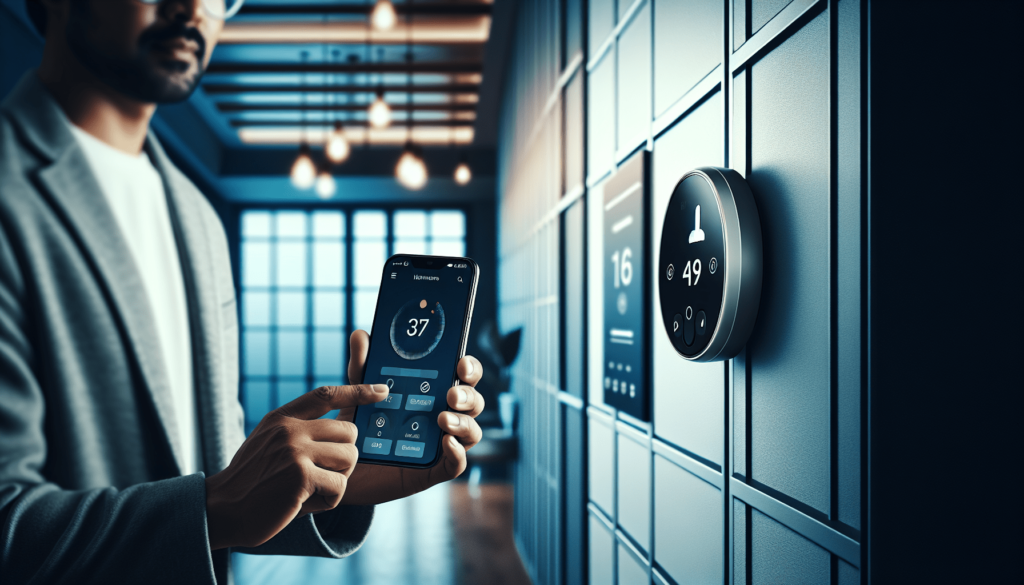
Future advancements in smart thermostat mobile apps
Artificial Intelligence integration
As technology continues to advance, smart thermostat mobile apps are expected to integrate more advanced artificial intelligence (AI) capabilities. AI integration can enhance the efficiency and intelligence of smart thermostats by leveraging machine learning algorithms and predictive analytics.
With AI integration, smart thermostat mobile apps can learn from your behaviors, preferences, and energy usage patterns to provide more personalized and predictive temperature control. They can adapt to your routines, automatically adjust settings based on historical data, and optimize energy consumption accordingly.
Furthermore, AI integration can enable more sophisticated automation and decision-making capabilities. For example, the app can proactively suggest or apply temperature adjustments based on predicted weather conditions or occupancy patterns, further enhancing comfort and energy savings.
Enhanced energy optimization algorithms
Smart thermostat mobile apps are continuously evolving to improve energy optimization algorithms. These algorithms analyze data from various inputs, such as temperature, occupancy, and weather, to dynamically adjust temperature settings and optimize energy consumption.
As technology advances, these algorithms are expected to become more advanced and accurate. They may better identify patterns, recognize outliers, and provide more precise recommendations for energy-saving practices.
Additionally, enhanced energy optimization algorithms may integrate with external data sources, such as utility pricing data or grid demand patterns. This can enable the smart thermostat to make real-time decisions about temperature adjustments to take advantage of lower electricity rates or support broader energy conservation initiatives.
Improved user interfaces
User interfaces (UI) of smart thermostat mobile apps are likely to undergo continuous improvements in the future. These improvements focus on enhancing usability, intuitiveness, and customization options to provide a superior user experience.
Future UI enhancements may include more visual representations of energy usage, intuitive controls, and simplified navigation within the mobile app. The goal is to make it easier for users to navigate through the app, access relevant information, and make informed decisions about their home’s climate control.
Additionally, improved UIs may incorporate more personalization options to tailor the app’s appearance and functionality to individual preferences. Users may have the ability to select preferred themes, customize dashboards, or rearrange sections within the mobile app to suit their needs.
Conclusion
Smart thermostats, coupled with their mobile app control, bring a new level of convenience, accessibility, and energy efficiency to home climate control. With the ability to adjust temperature settings remotely, create custom schedules, and monitor energy usage, smart thermostat mobile apps empower users to take control of their home’s comfort and energy consumption.
The compatibility of smart thermostats with mobile apps allows for seamless integration into our increasingly connected and automated homes. By supporting features like geofencing, weather integration, and smart home automation, mobile apps enhance the functionality and versatility of smart thermostats, providing a more comprehensive and intelligent user experience.
While enjoying the benefits of smart thermostat mobile apps, it is important to prioritize security and privacy. Protecting personal data, implementing strong passwords, enabling two-factor authentication, and keeping firmware and app updates current are essential practices to ensure a safe and secure smart home environment.
As technology continues to evolve, the future of smart thermostat mobile apps holds exciting possibilities. Integration with artificial intelligence, enhanced energy optimization algorithms, and improved user interfaces will further augment the convenience, efficiency, and appeal of smart thermostats, accelerating their popularity and adoption in modern homes.
